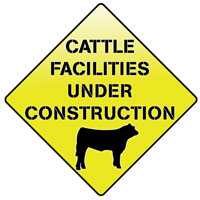Upgrade Your Cattle Handling Facilities

| Bonus Content: |
Working cattle is a task made much easier and safer in a well-designed handling system. A good handling system has many advantages, ranging from improved cattle health and production to labor savings and less stress on you and your cattle.
If you're thinking of building new facilities or upgrading your existing system, help is available from your local Extension office or from publications available on the Internet.
Equipment costs to build a system can range from $7,000 to $15,000, according to a publication from the University of Kentucky (UK) titled "Cattle Handling Facilities: Planning, Components, and Layouts." However, UK and Mississippi State University researchers who compiled the publication estimate a cattle handling system can be paid for in a few years from the benefits of better animal health and increased production. Return on investment. The researchers estimated that a 50-head cowherd could have cow–calf returns of more than $20 per head due to an increase in calving percentage and weaning weights. The researchers based their estimates on several factors.
Return on investment. The researchers estimated that a 50-head cowherd could have cow–calf returns of more than $20 per head due to an increase in calving percentage and weaning weights. The researchers based their estimates on several factors.
Processing facilities that are used to provide an adequate health program for cows and calves should help increase an operation's calving percentage, reduce calf death rate from birth to weaning, decrease the breeding herd death rate and increase weaning weights.
To pare costs, a producer can start with a basic system that includes a chute and headgate, says John Kearney of Lexington, Neb. He is a district manager for Behlen Manufacturing, Inc., maker of Big Valley cattle handling equipment.
"With only a chute and headgate, a producer can keep costs to a bare minimum using a straight alley with an open-sided working facility," Kearney says.
For a few more dollars, producers may want to add a sheeted system with a curved alley and a palpation cage to make it easier to work cattle. The top end of a working system could include a hydraulic chute and scales with an indicator that stores the animal's weight and keeps a tally of vaccinations for each animal.
Kearney says costs for a basic handling system start at about $5,500. A top-end system ranges up to $15,000, depending on the options for the chute, scales and indicator. For example, indicators can range from $700 for a simple screen that records only animal weights to $3,000 for one that stores up to 12 characteristics and is Bluetooth adaptable.
"A lot of people with 50- to 150-head cowherds put in a hydraulic chute with scales and indicator because they want every dollar to count. Often they are the sole proprietor and need a system they can manage alone," Kearney says.
More considerations beyond cost. "Regardless of the system you purchase, safety is the most important factor, for the operator as well as reducing stress on the animal," Kearney says.
A well-planned cattle handling facility will put minimal stress on both you and your animals. Consider whether the cattle are flowing in only one direction through a system, whether the gates are placed in the right location and swing in the correct direction and whether the pens, fences and other parts of a facility are strong and solid enough to hold the cattle during moving and processing.
Avoid areas that can trap cattle such as dead ends and bottlenecks. Eliminate, or at least heavily pad, any corners or sharp areas that can bruise or injure cattle moving through a system. Also, try to avoid high contrasts of bright light and deep shadows that will make cattle balk. It's best to position the loading and squeeze chutes north and south to reduce the effect of bright sunlight on equipment.
This winter might be a good time to put pencil to paper and plan the cattle handling system you've been thinking about building, or tweak the one you already have to make cattle handling more productive. BT







